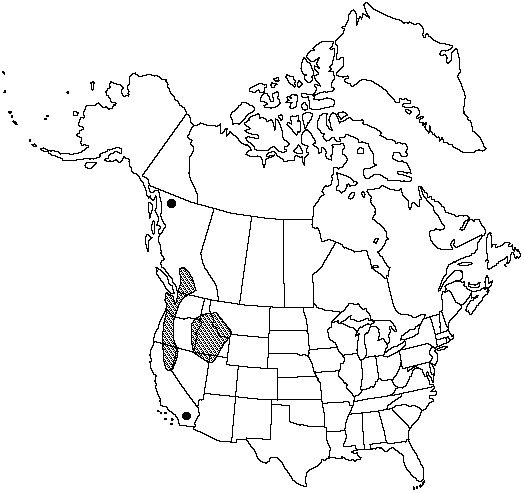Difference between revisions of "Polystichum kruckebergii"
Amer. Fern J. 56: 4. 1966.
FNA>Volume Importer |
FNA>Volume Importer |
||
| Line 17: | Line 17: | ||
}}<!-- | }}<!-- | ||
| − | --><span class="statement" id="st- | + | --><span class="statement" id="st-undefined" data-properties=""><b>Stems </b>ascending. <b>Leaves</b> erect, 1–2.5 dm; bulblets absent. <b>Petiole</b> 1/10–1/5 length of leaf, sparsely scaly; scales light brown, gradually diminishing in size distally. <b>Blade</b> linear, 1-pinnate-pinnatifid, base narrowed. <b>Pinnae</b> rhombic-ovate to short-falcate, proximal pinnae ± triangular; pinnae overlapping, twisted somewhat out of plane of blade, 0.5–1.5 cm; base oblique, acroscopic auricle well developed; margins shallowly incised to merely dentate or serrulate, teeth spreading and spiny at tip; apex acute with subapical and apical teeth same size; microscales lanceolate with few projections, confined to costa, on abaxial surface only. <b>Indusia</b> entire. <b>Spores</b> dark brown. <b>2n</b> = 164.</span><!-- |
-->{{Treatment/Body | -->{{Treatment/Body | ||
| Line 46: | Line 46: | ||
|publication year=1966 | |publication year=1966 | ||
|special status= | |special status= | ||
| − | |source xml=https://jpend@bitbucket.org/aafc-mbb/fna- | + | |source xml=https://jpend@bitbucket.org/aafc-mbb/fna-data-curation.git/src/9216fc802291cd3df363fd52122300479582ede7/coarse_grained_fna_xml/V2/V2_25.xml |
|genus=Polystichum | |genus=Polystichum | ||
|species=Polystichum kruckebergii | |species=Polystichum kruckebergii | ||
| − | |||
| − | |||
| − | |||
| − | |||
| − | |||
| − | |||
| − | |||
| − | |||
| − | |||
| − | |||
| − | |||
| − | |||
| − | |||
| − | |||
| − | |||
| − | |||
| − | |||
| − | |||
| − | |||
| − | |||
| − | |||
| − | |||
| − | |||
| − | |||
| − | |||
| − | |||
| − | |||
| − | |||
| − | |||
}}<!-- | }}<!-- | ||
-->[[Category:Treatment]][[Category:Polystichum]] | -->[[Category:Treatment]][[Category:Polystichum]] | ||
Revision as of 14:15, 27 July 2019
Stems ascending. Leaves erect, 1–2.5 dm; bulblets absent. Petiole 1/10–1/5 length of leaf, sparsely scaly; scales light brown, gradually diminishing in size distally. Blade linear, 1-pinnate-pinnatifid, base narrowed. Pinnae rhombic-ovate to short-falcate, proximal pinnae ± triangular; pinnae overlapping, twisted somewhat out of plane of blade, 0.5–1.5 cm; base oblique, acroscopic auricle well developed; margins shallowly incised to merely dentate or serrulate, teeth spreading and spiny at tip; apex acute with subapical and apical teeth same size; microscales lanceolate with few projections, confined to costa, on abaxial surface only. Indusia entire. Spores dark brown. 2n = 164.
Habitat: Rocks and cliffs in subalpine to alpine habitats
Elevation: 1500–3200 m
Distribution

B.C., Calif., Idaho, Mont., Nev., Oreg., Utah, Wash.
Discussion
Polystichum kruckebergii is widely but sporadically distributed in small numbers in both the Sierra-Cascade and Rocky Mountain systems. Populations sometimes consist of only two or three dwarfed plants that are difficult to distinguish from P. scopulinum, with which they may occur. The spreading teeth of equal size at the pinna apex will usually distinguish this species. Polystichum kruckebergii is a tetraploid presumed to be of hybrid origin, with P. lonchitis and P. lemmonii as its diploid progenitors (W. H. Wagner Jr. 1973), although this hypothesis has not been confirmed. The hybrid with P. munitum has been found in Washington (P. S. Soltis et al. 1987) with both parents, and it is distinguished by intermediate morphology and abortive sporangia.
Selected References
None.